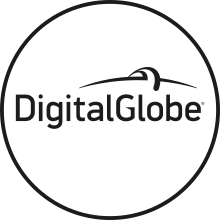디지털글로브
DigitalGlobe | |
| 유형 | 자회사 |
|---|---|
| 산업 | 위성 이미지 |
| 설립. | 1992년 1월 |
| 설립자 | 월터 스콧 |
| 본사 | 미국 콜로라도 주 웨스트민스터 |
서비스 지역 | 전 세계 |
주요 인물 | 제프 컬웰 시니어운영 담당 부사장 |
| 상품들 | 고해상도 위성 이미지 및 지리 공간 솔루션 |
| 수익. | 6억 5460만달러 (2014년)[1] |
| 2,540만달러 (2014년) | |
| 1,850만달러 (2014년) | |
| 총자산 | 3,09520만달러 (2014년) |
종업원수 | 1,200 (2014년) |
| 부모 | Maxar 테크놀로지스 |
| 웹 사이트 | www |
DigitalGlobe는 미국의 우주 이미지 및 지리 공간 콘텐츠 업체이자 민간 원격 감지 우주선 운영업체입니다.이 회사는 2009년 5월 14일 뉴욕증권거래소에 상장하여 1천470만주를 각각 19.00달러에 매각하여 2억7천900만 달러의 자본금을 조달하였다.2017년 10월 5일 Maxar Technologies는 DigitalGlobe [2]인수를 완료했다.
회사의 "WorldView" 위성은 관련이 없는 WorldView 회사(성층권 풍선 운영자)와 혼동해서는 안 됩니다.
오리진스
WorldView Imaging Corporation은 1992년 10월 제정된 Land Remote Sensing Policy Act(1992년 10월 제정)를 앞두고 1992년 1월 캘리포니아 오클랜드에서 설립되어 민간 기업의 위성 이미징 [3]사업 진출을 허용했습니다.설립자는 Walter Scott 박사로 1992년 말 공동 설립자이자 CEO인 Doug Gerull이 합류했습니다.1993년, 동사는 1992년 [4]법률에 근거해 최초의 고해상도 상업용 리모트 센싱 위성 면허를 취득했다.이 회사는 처음에는 실리콘밸리 공급원 및 북미, 유럽 및 일본의 관심 기업으로부터 민간 자금 지원을 받았습니다.스콧 박사는 로렌스 리버모어 연구소 "찬란한 조약돌"과 "찬란한 눈" 프로젝트의 책임자로, 전략 방위 구상의 일부였다.Doug Gerull은 Intergraph [5]Corporation의 매핑 과학 부문 책임자였습니다.이 회사는 미국 상무부로부터 최초로 원격감지 허가를 받아 해상도 [3]3m(9.8피트)의 영상을 수집할 수 있는 상용 원격감지 위성을 제작할 수 있게 되었습니다.
1995년 회사는 어스워치 주식회사가 되어 WorldView와 Ball Aerospace & Technologies Corp.의 상업용 원격 감지 [6]사업을 합병했습니다.
2001년 9월, EarthWatch는 DigitalGlobe가 [7]되었습니다.
2007년에 DigitalGlobe는 온라인 이미지 프로바이더 GlobeXplore를 인수하여 온라인 API 및 웹 [8]서비스를 통한 이미지 배포 기능을 확장했습니다.
2011년, DigitalGlobe는 상업용 지구 촬영 [9]위성을 발전시키는 데 기여한 공로로 Space Foundation의 Space Technology Hall of Fame에 입성했습니다.
2013년에 DigitalGlobe는 GeoEye를 [10][11]인수했습니다.
2017년 2월 맥도날드, Dettwiler and Associates(MDA) 및 DigitalGlobe는 MDA가 24억 [12]달러에 디지털글로브를 인수하기로 합의했습니다.2017년 5월 현재 DigitalGlobe의 이미지 카탈로그에는 100페타바이트의 데이터가 포함되어 있으며 매일 [13]100테라바이트씩 증가하고 있습니다.2017년 10월 5일 현재 MDA는 DigitalGlobe [2]인수를 완료했다고 발표했습니다.2017년 10월 5일 디지털글로브와 MDA홀딩스컴퍼니가 합병하여 Maxar Technologies가 되었다.
2019년 12월 30일, Northern Private Capital이 이끄는 금융 스폰서 컨소시엄에 MDA를 10억 캐나다 달러(7억 6500만 달러)에 매각하기로 최종 합의했다고 발표했다.판매에는 지상국, 레이더 위성 제품, 로봇 공학, 방위 및 위성 부품을 포함한 MDA의 모든 캐나다 사업체가 포함되었으며, 약 1,900명의 직원을 대표한다.[15]
2020년 4월 8일, NPC에 대한 MDA 자산 매각이 공식적으로 종료되었다.새로 설립된 캐나다 민간기업의 이름은 [16][17]MDA였다.
위성
얼리버드-1
EarlyBird-1(COSPAR 1997-085A) 상용 지구 이미징 위성은 CTA Space Systems(나중에 Orbital Sciences Corporation의 일부)가 EarthWatch Inc.를 위해 제작했으며, 1997년 12월 24일 Svobodny Cosmodrome에서 Start-1 [18]발사체에 의해 발사되었다.질량은 317kg(699lb)이고 설계 수명은 3년(5년간 연료 비축량)이었다.해상도 3m(9.8피트)의 범크로매틱(흑백) 카메라와 해상도 15m(49피트)의 멀티 스펙트럼(컬러) 카메라를 탑재했다.영상 센서는 1998년에 취소된 클라크라고 불리는 NASA 위성에서 파생되었다.[19]얼리버드-1은 스보보드니 우주기지에서 발사된 최초의 상업용 위성이다.발사는 성공적이었지만 위성은 전력시스템 고장으로 [20]궤도에 진입한 지 불과 4일 만에 통신이 두절됐다.
아이콘
IKONOS는 1999년 9월 24일 출범했다.해상도 0.8m(2피트 7인치)의 범색(흑백) 영상과 3.2m(10피트)의 [21]멀티 스펙트럼(컬러) 영상을 수집한 세계 최초의 고해상도 상용 영상 위성이다.2015년 3월 31일, IKONOS는 공식적으로 그녀의 미션 디자인 수명을 두 배 이상 늘린 후, 궤도에서 5,680일을 보내고 [22]83,131번의 지구 일주 여행을 한 후 해체되었다.
퀵버드
2001년 [6]10월 18일 발사된 QuickBird는 2015년 초까지 디지털글로브의 주요 위성이었다.그것은 Ball Aerospace에 의해 만들어졌고 Boeing Delta II에 의해 발사되었다.고도 450km(280mi), 경사 98° 태양 동기 궤도입니다.이전의 발사 시도는 QuickBird-1의 손실을 가져왔다.이후 시리즈의 두 번째 위성인 QuickBird-2가 발사되었고 QuickBird로 간단히 알려지게 된 것은 이 위성이다(다른 QuickBird 위성은 발사되지 않았기 때문에).60cm(24인치) 해상도의 범크로매틱 카메라와 2.4m(7피트 10인치) 해상도의 멀티 스펙트럼 카메라를 탑재했다.2015년 1월 27일 QuickBird는 궤도를 이탈하여 초기 기대 수명을 거의 300%[22] 초과했습니다.
GeoEye-1
GeoEye-1 위성은 0.41m(1ft 4인치)의 범색(흑백) 및 1.65m(5ft 5인치)의 다중 스펙트럼 해상도로 이미지를 수집합니다.이 위성은 하루에 최대 35만2 km(14만 평방 mi)의 다중 스펙트럼 이미지를 수집할 수 있다.이것은 대규모 매핑 프로젝트에 사용됩니다.GeoEye-1은 3일 또는 그 이전에 지구의 어느 지점을 다시 방문할 수 있다.
월드뷰 위성 시스템
월드뷰-1
Ball Aerospace는 WorldView-1을 [23]구축했습니다.2007년 9월 18일 델타 II 7920-10C의 반덴버그 공군기지에서 발사되었다.출시 서비스는 United Launch Alliance(ULA)에 의해 제공되었습니다.NGIA(National Geospace-Intelligence Agency)는 WorldView-1 [24]이미지의 주요 고객이 될 것으로 예상됩니다.여기에는 최대 해상도가 50cm(20인치)인 범크로매틱 전용 카메라가 포함되어 있습니다.
월드뷰-2
Ball Aerospace는 WorldView-2를 만들었습니다.그것은 2009년 10월 8일에 시작되었다.DigitalGlobe는 Boeing 상용 출시 서비스와 제휴하여 WorldView-2를 태양 동기 [25][26]궤도로 전송했습니다.이 위성은 최대 분해능 46cm(18인치)의 범색 센서와 184cm(72인치)[27]의 멀티 스펙트럼 센서를 포함합니다.
월드뷰-3
Ball Aerospace는 WorldView-3를 만들었습니다.2014년 8월 13일에 출시되었습니다.최대 해상도는 25cm(9.8인치)입니다.WorldView-3는 고도 617km(383mi)에서 작동하며, 하루 평균 재방문 시간이 1회 미만이다.하루 동안 최대 68만2 km(260,000 평방 mi)[28]의 이미지를 수집할 수 있습니다.
이전에 DigitalGlobe는 50cm(20인치) 이상의 고해상도 이미지를 [29]미군에게만 판매할 수 있는 허가를 받았습니다.그러나 DigitalGlobe는 2014년 6월 미국 상무부로부터 자사의 상업 위성 이미지를 보다 광범위하게 활용할 수 있는 허가를 받았습니다.이 회사는 고객에게 별자리에서 사용할 수 있는 최고 해상도의 이미지를 제공할 수 있도록 허용되었습니다.또한 업데이트된 승인을 통해 WorldView-3가 가동되고 6개월 후부터 최대 25cm(9.8인치)의 범색 및 100cm(39인치)의 GSD(멀티 스펙트럼 그라운드 샘플 거리)에서 고객에게 이미지를 판매할 수 있었습니다.월드뷰-3는 2014년 8월 13일 18시 30분 반덴버그 공군기지 [30]반덴버그 우주발사단지 3(SLC-3E)에서 401 구성으로 유나이티드 발사 얼라이언스 아틀라스 V 발사체로 발사되었다.
WorldView-3는 업계 최초의 다중 페이로드 초고분광 고해상도 상용 [31]위성입니다.
월드뷰-4
WorldView-4 위성은 31cm(12인치)의 최고 해상도와 124cm(49인치)[32]의 멀티 스펙트럼 이미지를 제공하도록 설계되었습니다.원래 이름이 GeoEye-2인 이 우주선은 록히드 [33]마틴에 의해 설계되고 만들어졌으며 카메라 탑재물은 [34]ITT Corporation이 제공했다.
2013년 GeoEye와 DigitalGlobe가 합병한 후,[35][36] DigitalGlobe는 GeoEye-2가 필요할 때나 필요할 때 출시될 수 있는 그라운드 스페어로 완성될 것이라고 발표했습니다.2014년 7월에 WorldView-4로 이름이 변경되어 2016년 [37][38]가을 출시 예정이 발표되었습니다.2016년 11월 11일 발사되었다.
2019년 1월에는 인공위성의 제어모멘트 자이로스코프 고장을 보고하여 인공위성이 작동하지 않게 [39]하였다.
월드뷰 군단
현재 SSL에 의해 구축되고 있는 WorldView Legion은 DigitalGlobe의 차세대 지구 관측 위성입니다.WorldView Legion은 태양 동기 궤도와 중위도 [40][41]궤도가 혼합된 상태로 2022년에 발사될 예정인 6개의 위성으로 구성되어 있다.이들 위성은 현재 DigitalGlobe의 WorldView-1,[42] WorldView-2 및 GeoEye-1 지구관측위성이 제공하는 이미징 기능을 대체할 것입니다.
6개의 월드뷰 군단 위성은 2022년에 [43]3개의 비행 테스트를 거친 SpaceX Falcon 9 발사체로 발사될 예정이다.
고객 및 경쟁사
DigitalGlobe의 고객은 도시계획가부터 Amazon Conservation [44]Team과 같은 환경보호단체, NASA와 미국 국방부의 NGA([45]National Geospatial-Intelligence Agency)를 포함한[7] 미국 연방기관에 이르기까지 다양합니다.Google 어스와 Google 지도의 고해상도 이미지 대부분은 DigitalGlobe에 [46]의해 제공됩니다.
DigitalGlobe의 주요 경쟁자는 Spot과 Playades [47]위성을 가진 Airbus입니다.
「 」를 참조해 주세요.
- 사진 측량
- 리모트 센싱
- 위성 감시기 프로젝트
- Tomnod는 크라우드소싱을 사용하여 위성 이미지에서 물체와 장소를 식별하는 디지털글로브 프로젝트입니다.
레퍼런스
- ^ a b c d "Annual Reports". DigitalGlobe. Archived from the original on 7 June 2017. Retrieved 25 February 2016.
- ^ a b "MDA-DG combined entity to be rebranded as Maxar Technologies". Geospatial World. Retrieved 6 October 2017.
- ^ a b Duman, Angie. "xyHt Positioning and Measurement, Elevated". eomonline.com. Archived from the original on 13 October 2008. Retrieved 25 February 2016.
- ^ "Our Company". DigitalGlobe. 21 August 2014. Archived from the original on 5 August 2014. Retrieved 25 February 2016.
- ^ Markoff, John (12 February 1993). "Company News – A Plan for Close-Up Images of Earth From Space". The New York Times. Retrieved 25 February 2016.
- ^ a b "DigitalGlobe – History". Archived from the original on 13 April 2006. Retrieved 19 April 2006.
- ^ a b "Scientific Data Purchase". NASA. Archived from the original on 29 September 2006. Retrieved 19 April 2006.
 이 문서에는 퍼블릭 도메인에 있는 이 소스로부터의 텍스트가 포함되어 있습니다..
이 문서에는 퍼블릭 도메인에 있는 이 소스로부터의 텍스트가 포함되어 있습니다.. - ^ "DigitalGlobe Buys Web Based Imagery Firm". SpaceNews. 29 June 2004. Retrieved 11 January 2007.
- ^ "Story". Space Foundation. Archived from the original on 4 October 2011. Retrieved 25 February 2016.
- ^ "DigitalGlobe Agrees to Acquire GeoEye for About US$900 Million". bloomberg.com. Archived from the original on 14 April 2016. Retrieved 9 June 2021.
- ^ "DigitalGlobe completes acquisition of GeoEye". Geospatial World. 1 February 2013. Retrieved 9 June 2021.
- ^ "MDA to acquire DigitalGlobe". SpaceNews. 24 February 2017.
- ^ Scoles, Sarah (17 May 2017). "The Best Way to Transmit Satellite Data? In Trucks. Really". Wired. Retrieved 31 August 2017.
- ^ "MDA-DG combined entity to be rebranded as Maxar Technologies". Geospatial World. 5 October 2017. Retrieved 3 November 2020.
- ^ "Maxar to Sell MDA for US$765 Million". Retrieved 3 November 2020.
- ^ "Iconic Space Technology Firm Returns to Canadian Control as Sale of MDA to Northern Private Capital Closes". newswire.ca. Retrieved 3 November 2020.
- ^ "MDA". MDA. Retrieved 3 November 2020.
- ^ "EarlyBird-1". NASA. Retrieved 25 February 2016.
 이 문서에는 퍼블릭 도메인에 있는 이 소스로부터의 텍스트가 포함되어 있습니다..
이 문서에는 퍼블릭 도메인에 있는 이 소스로부터의 텍스트가 포함되어 있습니다.. - ^ "Clark (SSTI 2)".
- ^ "EarlyBird-1".
- ^ "IKONOS Data Sheet" (PDF). Dg-cms-uploads.production.s3.amazonaws.com. Retrieved 25 February 2016.
- ^ a b "DigitalGlobe satellites IKONOS and QuickBird-2 retire after years of service". blog.tomnod.com. Archived from the original on 4 March 2016. Retrieved 25 February 2016.
- ^ "DigitalGlobe announces Ball building WorldView-2 satellite". Spaceflight Now. Retrieved 2 February 2007.
- ^ "A Satellite's First Breath". O'Reilly Media. Archived from the original on 22 September 2007.
- ^ "Boeing Selected to Co-Develop and Launch Next DigitalGlobe Imaging Satellite". Boeing. 2004. Archived from the original on 18 March 2006. Retrieved 19 April 2006.
- ^ "Delta II Worldview-2 mission booklet". NASASpaceFlight.com. Retrieved 25 February 2016.
- ^ "Features and Benefits for WorldView-2". Archived from the original on 8 October 2008. Retrieved 8 September 2008.
- ^ "WorldView-3 Data Sheet" (PDF). DigitalGlobe. Archived from the original (PDF) on 4 August 2014. Retrieved 25 February 2016.
- ^ Hollingham, Richard (11 February 2014). "Future – Inside the Google Earth satellite factory". BBC. Retrieved 25 February 2016.
- ^ "U.S. Department of Commerce Relaxes Resolution Restrictions DigitalGlobe Extends Lead in Image Quality". Archived from the original on 14 July 2014. Retrieved 29 June 2014.
- ^ "WorldView-3 Data Sheet" (PDF). Dg-cms-uploads.production.s3.amazonaws.com. Archived from the original (PDF) on 4 March 2016. Retrieved 25 February 2016.
- ^ "WorldView-4" (PDF). DigitalGlobe. November 2015. Archived from the original (PDF) on 24 April 2016. Retrieved 19 March 2016.
- ^ Ferster, Warren (11 March 2010). "Lockheed Martin Selected To Build GeoEye-2 Imaging Satellite". SpaceNews. Retrieved 2 April 2016.
- ^ Lockwood, Irene (10 April 2012). "ITT Exelis delivers imaging system for next-generation, high-resolution GeoEye-2 satellite" (Press release). ITT Exelis. Retrieved 2 April 2016.
- ^ "DigitalGlobe's WorldView-3 Satellite Continues on Track for Mid-2014 Launch" (Press release). DigitalGlobe. 4 February 2013. Archived from the original on 13 February 2013.
- ^ Ray, Justin (4 February 2013). "One commercial Earth-imager deferred in favor of another". Spaceflight Now. Retrieved 19 March 2016.
- ^ "DigitalGlobe Announces Second 30-Centimeter Satellite to Launch in Mid-2016" (Press release). DigitalGlobe. 31 July 2014. Archived from the original on 20 October 2016. Retrieved 2 April 2016.
- ^ Painter, Kristen Leigh (31 July 2014). "Demand moves DigitalGlobe to speed launch of high-powered satellite". The Denver Post. Retrieved 2 April 2016.
- ^ "Maxar Technologies Reports Failure of its WorldView-4 Imaging Satellite". Maxar. 7 January 2019.
- ^ Sheetz, Michael (5 August 2021). "Space company Maxar stock drops after delaying launch of next-generation satellites". CNBC. Retrieved 5 August 2021.
- ^ Krebs, Gunter (6 August 2021). "WorldView-Legion 1, ..., 6". Gunter's Space Page. Retrieved 8 October 2021.
- ^ Clark, Stephen (28 March 2018). "DigitalGlobe books two launches with SpaceX for Earth-imaging fleet". Spaceflight Now. Retrieved 12 April 2018.
- ^ Avery, Greg (23 February 2022). "Westminster-based Maxar's satellite launches shift to later in 2022". Yahoo Finance. Retrieved 25 February 2022.
- ^ "Amazon Conservation Team Presented with the Seeing a Better World Award". 8 August 2015.
- ^ "National Geospatial-Intelligence Agency Awards US$12 Million ClearView Contract to DigitalGlobe". 16 March 2006.
- ^ Hafner, Katie and Saritha Rai (20 December 2005). "Governments Tremble at Google's Bird's-Eye View". The New York Times.
{{cite news}}: CS1 maint: 작성자 파라미터 사용(링크) - ^ Effigis. "Main Commercial Earth Observation Satellites Distributor". Effigis. Retrieved 20 December 2021.


